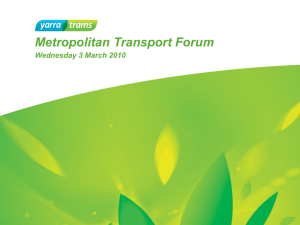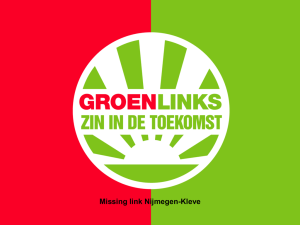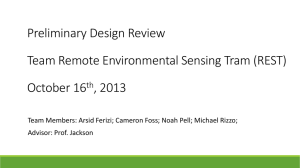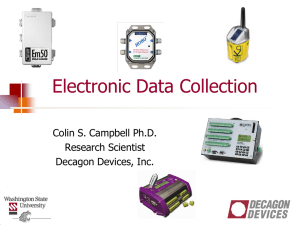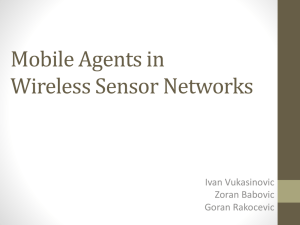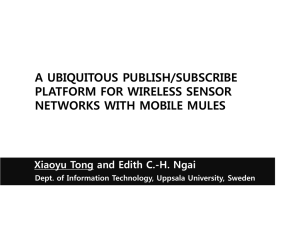MDR Slides
advertisement
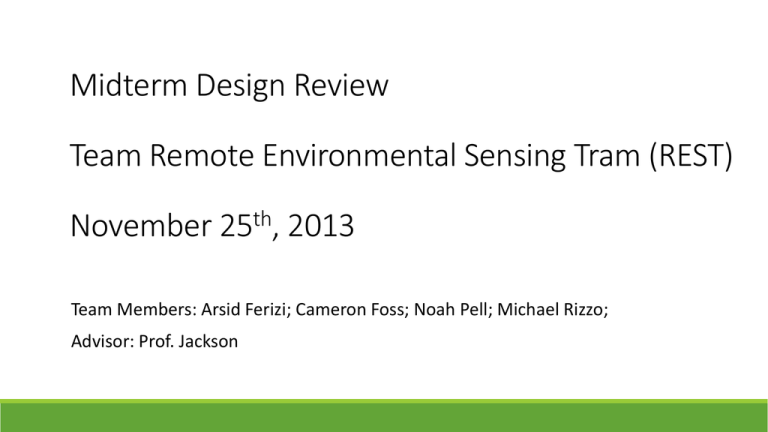
Midterm Design Review Team Remote Environmental Sensing Tram (REST) November 25th, 2013 Team Members: Arsid Ferizi; Cameron Foss; Noah Pell; Michael Rizzo; Advisor: Prof. Jackson Monitoring Forest Health Global Climate Change • Human-based control systems are limited Forest Health Monitoring • Inadequate means of analyzing a forest’s response to a variant This graph, based on the comparison of atmospheric samples contained in ice cores and more recent direct measurements, provides evidence that atmospheric CO2 has increased since the Industrial Revolution. Proposed Solution: Aerial Tram • REST will traverse a 50m transect, provide continuous on site data acquisition, and trend monitoring via a website Tram System Collecting Data in Harvard Forest Photo Courtesy of Professor Siqueira Proposed Solution: High Level Overview Tram • Autonomously collects data from sensors • Transmits collected data to the base station Tower (Base Station) • Communicates with tram, to give commands and receive environmental data • Send and receive commands and data to the UI over Ethernet User Interface • Access and display recorded and real time data • Process user commands and transmit them to the base station Solution: Block Diagram User Interface Requirements: • • • • Allows user to change multiple settings on the aerial tram Allows user to send controls for aerial tram to execute in real time Deliver sensor data visuals to user Process and display image and video data for the user Implementation: • Website • Supports graphical representation of environmental data • Scripted input to direct operation of tram • Supports images and video This website is used by a company to display their data collected from remote sensors http://mdw.srbc.net/remotewaterquality/data_viewer.aspx User Interface Current Accomplishments: • Python script polls the output file from data logger every 30 seconds, and updates if necessary • Google Charts graphs and Google Spreadsheets tabulates the gathered data • Motor moves and pictures are uploaded when commanded by the website CDR Primary Goals: • More attractive and user friendly • Improved data visuals • Parameterized • Improved integration of user commands • Allow for user to input a testing schedule and state transitions Current graph of the received sensor data TX/RX for UI-Base Station Communication Requirements: • Send and receive data over the internet to the aerial tram Photo Courtesy of Professor Siqueira Implementation: • Landline to base station Category 5 Cable http://picclick.com/NEW-1-FOOT-PINK-CAT-5E-350 MHZ-UTP-ETHERNET-NETWORK-281140500650.html Tram System – The “Base Station” is the shack located behind the blue structure Tx/Rx for Base Station-Tram Communication • Current Implementation: • Data Logger connects to on-tram computer through EtherComm TX Port Micro Switch • Ethernet from computer to base station • Proposed Communication Options: • Move Computer off Tram to Base Station and establish wireless communication • Industrial Cat5 cable DEV-11837 RaspberryPi Model A (with weather resistant case) XBEE ZB Pro Series 2 Transmitter on Tram Arduino Uno - R3 DEV-11021 XBEE ZB Pro Series 2 Transmitter on Base Station XBEE Series 1 Transmitter At Tram XBEE Series 1 Transmitter At Base Station Wireless Requirements Requirements: • Wireless • • • Range of at least 50m Adequate data rate Reasonable power consumption XBEE ZB Pro Series 2 Transmitter on Tram Implementation: • • RaspberryPi Model A to Xbee ZB RF module • Outdoor Range = 120m • Data Rate = up to 1Mbps • Power: 5V @ 300mA XBEE ZB Pro Series 2 Transmitter on Base Station DEV-11837 RaspberryPi Model A (with weather resistant case) Arduino Uno-R3 to Xbee Series 1 RF module • Outdoor/RF LOS Range = 100 m • Data Rate = 250 kbps • Power: 3.3 V @ 50mA Arduino Uno - R3 DEV-11021 XBEE Series 1 Transmitter At Tram XBEE Series 1 Transmitter At Base Station Wireless vs. Wired Trade-Offs • Wired Connection • Basic Cat5 subject to environmental deterioration • Industrial cables recommended for outdoors • Industrial Cable- ~$100 • Wireless Solution: • Less maintenance • Lower data transfer rates • ZigBee- ~$40 Conclusion: We prefer the wireless solution, however trade-offs indicate that either option will suffice. We will leave the option of wireless capabilities to the User. Tx/Rx (Tram-Base Station-Website) Current Accomplishments: • Wired transmission from tram to website • Wireless solution determined option at users preference CDR Secondary Goal: • Construct wireless modules solution • Order industrial cat5 cables Control System (Base Station) Requirements: • • • • Non-technical Process commands sent by the web application Perform data processing and storage at the base station Manage autonomous tram operation Implementation: • Driven by the state machine • Labview • Control of the virtual instruments • Python • Programmable connection to the network • Python and Labview LGX AU140 Extended Temperature Intel Atom Computer Platform http://www.logicsupply.com/media/manuals/LGX_AU140_Fanless_Computer_SpecSheet.pdf Control System (Base Station) Current Accomplishments: • State execution dictated by schedule • • CDR Primary Goals: • • Check Time Data Logger collects data when commanded by Labview Motor moves by 1m or 10m increments when commanded by Labview Move Back Initialize System Parameterized • Scheduling and state transitions based on user input Power down state Take Measurements Move Tram Motor Controls (Base Station) Requirements: • Move the tram according to a user defined distance Implementation: • Stepper Motor and Driver • Low vibration • 3 N•m torque up to 150 rpm Current Accomplishments: • Movement at a constant predefined speed CDR Primary Goals: • Movement necessary to achieve user defined distance http://www.orientalmotor.com/products/stepper-motors/AR-series-stored-data-controller-dc.html AR66AKD-T10-3, AlphaStep Closed Loop Stepper Motor and Drive with Built-in Controller Sensors and Controls (Tram) Requirements: • • • Capable of sensing radiation, vibration and distance Capable of visually observing surroundings Lightweight, reliable, reasonable power consumption Implementation: • Four Channel Net Radiometer • Pyranometer – SW 285-3,000 nm • Pyrgeometer – LW 4,500-40,000 nm • Spectral Reflectance Sensor • Normalized Difference Vegetation Index (NDVI) • 531±3 and 570±3 nm wavelengths • Photochemical Reflectance Index (PRI) • 630±5 and 800±5 nm wavelengths http://www.hukseflux.com/product/nr01-net-radiometer?referrer=/product_group/pyranometer http://www.hoskin.ca/catalog/index.php?main_page=product_info&products_id=2611 Four Channel Net Radiometer Spectral Reflectance Sensor Sensors and Controls (Tram) Implementation: • Accelerometer • Resolution – 3.9 mg/LSB (typical) • Shock survival - 10,000 g (maximum) • SPI or I2C digital interface • Power consumption - 140 μA (typical) at 3.3 V • Ultrasonic sensor • Suitable for outdoor applications • Distance - 50cm to 10m • Accuracy - within +/-1% over the distance range • Resolution - 10mm (max) • Power consumption – 3.1mA at 5V http://www.adafruit.com/products/163?gclid=CJ2B0t-mmroCFZKk4Aod9wkAZQ http://www.maxbotix.com/Ultrasonic_Sensors/MB7386.htm ADXL335 - triple-axis accelerometer HRXL-MaxSonar®-WRLT™ Sensors and Controls (Tram) Implementation: • Webcam • HD video – 720p/1080p • Photos – Up to 15 megapixels • Infrared Thermometer • Operating Range - -55 to 80C • Sensitivity - 60 uV per C Logitech HD Webcam C920 http://www.logitech.com/en-us/product/hd-pro-webcam-c920 http://www.hoskin.ca/catalog/images/Apogee_SI-111.jpg Apogee Infrared Thermometer Sensors and Controls (Tram) Requirements: • Organize sensor data and commands into packets for communication between base station and tram. Implementation: • CR1000 Data Logger • Analog inputs • 16 single-ended (8 differential) channels • Digital I/O • SDI-12, UART, RS232 • 4MB memory http://www.campbellsci.com/cr1000 CR1000 Data Logger Sensors and Controls (Tram) Current Accomplishments: • Sensors(4 channel radiometer, NDVI, PRI, Infrared Thermometer, Webcam, Ultrasonic) collect data when labview sets a port on the data logger • Camera takes a picture via python script, and uploads it to website Current Set backs: • All of the data logger’s analog channels have been used/digital accelerometers unable to communicate with logger directly • Ultrasonic sensor is not suitable for outdoor applications CDR Primary Goals: • Parameterized • Ultrasonic sensor better suited for the application • Accelerometer communicating with Raspberry Pi board and python script Power Management (Tram) Device of Interest Max Voltage(V) Max Current (A) Avg. Power (W) Power (W/h) Average Daily Operation Time(hrs) Ultrasonic Sensor 12 50m .6 4.8 8 NDVI(x2) 12 383u 9.552m 76.716m 8 PRI(x2) 12 398u 9.192m 73.536m 8 Data Logger 12 100m 1.2 9.6 8 Ethernet Switch 12 158m 1.896 15.168 Total Tram 12 258m 3.096 24.768 Requirements: • 12 Volt supply @ 350 mA Current Implementation: • Wired connection 8 Power Management (Tram) Wireless Charging and Management Solution: • Inductive Charging • 12VDC rechargeable Battery Current Accomplishments: • Total Power calculations and Wireless Charging Block diagram CDR Goals: • Full Charging circuit design Power Management (Tram) Requirements: • Switches to battery source if power line goes down • Enters a low power state Implementation: • RaspberryPi • Power consumption: 5V @ 300mA • Battery • 12VDC 12Ah • Provides at least 24 hrs of battery supply while land line is down. • Would like to implement a wireless charging station via Inductive charging to maintain a charged battery. Proposed MDR Deliverables Primary Goals: • Demonstration of data collection from environmental sensors • Demonstration of tram and base station communication • Demonstration of website and tram basic interaction • Tram is able to send and receive test data • Website displays test data, and is able to send text data to tram Proposed CDR Deliverables Primary Goals: • Website – attractive UI with adequately functioning user input (commands, test schedule, state transitions) and visuals (graph, table, pictures) • Base Controls - scheduling and state transitions based on user input, and a power down state • Sensors and Motor Controls – integration of accelerometer and motor speed based on user input • Power Management and Communication – integration of secondary power supply, and power controller Secondary Goals: • Website and Base Controls – error handling • Sensors and Motor Controls – sensor measurements based on user input and error handling • Power Management and Communication – wireless communication between tram sensors/webcam and base station Tertiary Goals: • Sensors and Motor Controls – positioning system • Power Management and Communication – error handling Costs and Weight Item Cost Item Tram Weight RaspberryPi Model A $29.95 Tram and support frame 35lbs Weather Case for RaspPi <$10 Battery 14.33lbs Battery x2 $51.54 Total 49.33 Accelerometer $24.95 UltraSonic Sensor $119.95 Totals $236.39 Team REST’s Schedule Task Task Leader Week of Week of December 16th December 23rd (Break Week) Week of January 2nd Week of January 6th Week of January 13th Week of January 20th Week of January 27th Week of February 3rd Primary Goals: Integration of accelerometer Mike x x Attractive and functional UI Arsid x x Power Management (Base Station/Tram) Cameron x x Scheduling and state transitions Noah x x x x x x x Arsid/Noah x x x Mike x x x Cameron x x x Secondary Goals: Website and Base Controls – error handling Sensors and Motor Controlserror handling/user commands Motor Controls – user commands Tertiary Goals: Positioning system Mike Power Management and Communication-error handling Cameron x x x x x Week of February 10th Week of February 17th Questions….


